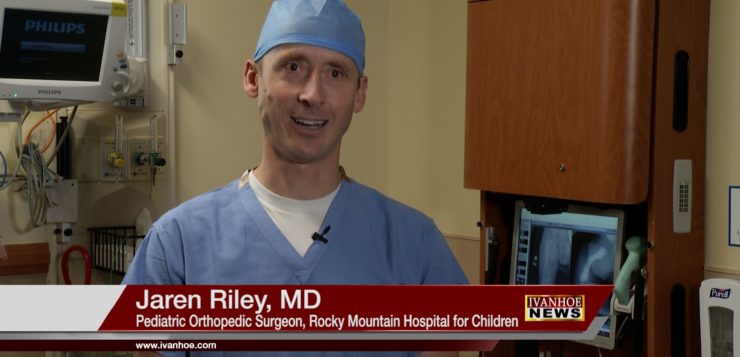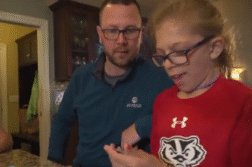Jaren Riley, MD, pediatric orthopedic surgeon at Rocky Mountain Hospital for Children specializes in scoliosis and hip reconstructions, talks about genetic disorders passed down from mother to baby and how to treat it.
Can you explain what is hypophosphatasia, or HPP?
Dr. Riley: First of all, in this specific patient, she has a rare disorder that doesn’t allow her bones to form the correct way and makes them extremely brittle. The way that we were able to figure this out was on a prenatal ultrasound. When we first saw the pictures, we could see that several of her bones, even her largest bones like the femur, were either misshapen or had already broken. You can imagine even in a mother who already had two healthy kids how devastating a revelation that would be. So, when I first met this family, it was just after they had understood and heard that her bones were way too brittle and that this may indicate a difficulty with her even being able to survive childbirth.
Have you seen this very often?
Dr. Riley: I’ll meet a family due to an abnormal prenatal ultrasound a few times a month. Sometimes, it’s because the family finds out their child has a congenital scoliosis or curvature of the spine due to a malformation of the spine. Other times, it’s for a diagnosis like this, osteogenesis imperfecta or anything along the lines of a bone brittle disease. These are difficult appointments but I actually really like these appointments because the families usually come in really scared out of their minds. I don’t think there’s any more stressful situation than a mom who is worried about the health of her unborn child. And in this case, to have such a broad spectrum of diseases that this could have been and initially was, was very difficult to nail down the diagnosis. There’s that additional element of not knowing exactly what the problem is. Then to receive the terrible information that this child may not even survive childbirth, that’s a pretty scary situation for a family to be in. So, I enjoy these interactions because it gives me the opportunity to at least talk to the family about what exactly is going on and if things go our way what we could do to help that baby out.
And, what did you do for Peyton?
Dr. Riley: I have done absolutely nothing for Peyton. Peyton is an absolute miracle and there’s no other way to describe it. First of all, I think the obstetricians and the pediatricians did a really good job at talking to the family about what the possible diagnoses were. They called me and some doctors even at other hospitals to try to get as many minds thinking about this baby as possible. Then, when the family met with me they had already been told that this young lady may not survive childbirth. I didn’t really feel like my role was to confirm that or deny it but was simply to say to the family as she is born, these are the things we can do to protect her bones as well as we possibly can. If more of them break, I’m the guy who straightens them, I’m the guy who splints them and gets them to heal the right way. And if she by some miracle lives, then I’ll be the guy who watches her grow her whole life. Whatever difficulties we run into, then we’ll help you get through those difficulties. But the crazy truth is that with all of us being ready for the worst thing to happen and all of us praying for this little girl, and especially the family who wanted a little girl so badly, the truth is I did nothing to help this girl and she survived childbirth beautifully. She did not break an additional bone to those we already knew were broken. So, something about Peyton herself carried her through that along with the absolute expert care of the obstetricians.
Has she had any fractures or anything since birth?
Dr. Riley: So, miracle number one was she was born. Her tiny little chest and those tiny little fragile ribs moved air in and out really well. She breathed very nicely. She didn’t fracture any additional bones during the birth process. I just saw her recently for her one-year exam and she had no additional fractures. All the care she’s receiving from multiple doctors to help her with her bone metabolism and bone health is paying off. In fact, when we did her new X-rays, there were significant improvements in all of the bones that had been either misshapen or broken prior. They really look fantastic.
Will she need to be watched for the rest of her life?
Dr. Riley: She’ll need constant monitoring at least through the completion of growth. And then as time goes by, her care will transition to other doctors such as endocrinologists who see a lot of women as they age because of decreasing bone mineral density. She’ll probably have to go through that same process.
What does this mean for her? Will she be able to play soccer and do all that kid stuff?
Dr. Riley: I would hate to put too many constraints on Peyton because we’ve already seen that she doesn’t seem to care what we think about what her prognosis is. So, initially we’re going to be careful. I’m not going to let this girl go on the trampoline with her brothers. They’re the sweetest boys in the whole world and I’m sure they would take care of her, but we are going to take certain precautions. She’s already hitting her usual motor milestones. She’s standing. She’s walking. She’s running. So, she’s trying to keep up with her brothers. We’re going to try to rein her in a little bit and just see what those bones can handle as she ages.
Do you have anything else that you give her for her bone care like medicines and things like that?
Dr. Riley: Yes. She does receive medicines that help stimulate a greater bone mineral density and of course simple things like supplementing vitamin D and calcium can help. Then, really the fact that she learned how to walk is huge because weight bearing is going to supply the stress that stimulates those bones to continue to develop also.
Is this a painful problem that she’ll have later in life?
Dr. Riley: If the bones continue to be somewhat brittle and she experiences multiple fractures, which is what we would predict, it’s an incredibly painful thing. If we can help her through the use of medications and activity modifications to have as few fractures as possible, then it really should not be painful at all. This is another wonderful example of Peyton’s body learning how to develop normal bones. This is an example of her humerus – her upper arm bone – and her radius and ulna, which are her forearm bones at the time of birth. You can see how significantly angulated and misshapen they are. One year later, through her own devices, she has grown a very straight humerus and has completely straightened her radius and ulna. She’s doing a tremendous job of normalizing her mechanics and her anatomy.
So, it sounds like you are just in awe of Peyton?
Dr. Riley: I’m blown away by Peyton. Yes, she is a bona fide miracle. There’s no other way to describe her. I am largely a spectator in her care because she really is taking care of herself as well as I ever could have.
Interview conducted by Ivanhoe Broadcast News.
END OF INTERVIEW
This information is intended for additional research purposes only. It is not to be used as a prescription or advice from Ivanhoe Broadcast News, Inc. or any medical professional interviewed. Ivanhoe Broadcast News, Inc. assumes no responsibility for the depth or accuracy of physician statements. Procedures or medicines apply to different people and medical factors; always consult your physician on medical matters.
If you would like more information, please contact:
Mari Abrams
720-754-4287
Mari.Abrams@Healthonecares.Com
Sign up for a free weekly e-mail on Medical Breakthroughs called First to Know by clicking here




